 China,
like many countries, is divided up into provinces (or states).
Baiyunebo (Bayan Obo) is in the
northern province of Inner Mongolia (Nei Mengu) along the border with
the country of Mongolia. The sovereign nation of Mongolia is
highlighted in red on the map. The province of Inner Mongolia is
highlighted in yellow. The star indicates Beijing.
China,
like many countries, is divided up into provinces (or states).
Baiyunebo (Bayan Obo) is in the
northern province of Inner Mongolia (Nei Mengu) along the border with
the country of Mongolia. The sovereign nation of Mongolia is
highlighted in red on the map. The province of Inner Mongolia is
highlighted in yellow. The star indicates Beijing. The Mongolian people have a very rich history and are truly fascinating people (although I imagine they'd probably tell you that they are just plain normal and we're the curiosities!).
 Signs
in Inner Mongolia are written in both Chinese characters and the Mongolian alphabet.
Chinese characters have the advantage that they represent meaning,
regardless of how you pronounce the words, so people from southern
China that speak Cantonese can communicate with the rest of
Mandarin-speaking China. There are radicals built into the
Chinese characters that can help you pronounce the words, but you need
to memorize them. The Mongolian language uses an alphabet (on the
left in this photo) that allows you to pronounce the words, but does
not tell you the meaning of the word, similar to alphabetic languages
in the west.
Signs
in Inner Mongolia are written in both Chinese characters and the Mongolian alphabet.
Chinese characters have the advantage that they represent meaning,
regardless of how you pronounce the words, so people from southern
China that speak Cantonese can communicate with the rest of
Mandarin-speaking China. There are radicals built into the
Chinese characters that can help you pronounce the words, but you need
to memorize them. The Mongolian language uses an alphabet (on the
left in this photo) that allows you to pronounce the words, but does
not tell you the meaning of the word, similar to alphabetic languages
in the west. The
streets in Baiyunebo are nice and wide and were in excellent
condition. I'd expected potholes like we have in Pennsylvania,
but potholes were pretty limited.
The
streets in Baiyunebo are nice and wide and were in excellent
condition. I'd expected potholes like we have in Pennsylvania,
but potholes were pretty limited. The
people in Baiyunebo were incredible! These folks were in the
central plaza when Zach and I went to look around on the first
day. Westerners are a pretty rare sight, so many people were
curious about us and everyone was extraordinarily friendly.
The
people in Baiyunebo were incredible! These folks were in the
central plaza when Zach and I went to look around on the first
day. Westerners are a pretty rare sight, so many people were
curious about us and everyone was extraordinarily friendly.  One
of the two seed and nut sellers near the central plaza, this woman
always had a smile.
One
of the two seed and nut sellers near the central plaza, this woman
always had a smile.
 We
would alternate buying sunflower seeds between the two seed and nut
sellers. Both used a simple balancing scale to measure their
product. The Chinese and their levers - they move the world just
like Archimedes said 2200 years ago!
We
would alternate buying sunflower seeds between the two seed and nut
sellers. Both used a simple balancing scale to measure their
product. The Chinese and their levers - they move the world just
like Archimedes said 2200 years ago!
 The
central plaza had a great fountain with lights and a water show.
I suspect it was paid for by profits from the mine. People from
all over town would collect here each evening for a quiet walk or to
watch children play. The Chinese have an incredible sense of
community this way - something I really respect and admire.
The
central plaza had a great fountain with lights and a water show.
I suspect it was paid for by profits from the mine. People from
all over town would collect here each evening for a quiet walk or to
watch children play. The Chinese have an incredible sense of
community this way - something I really respect and admire. Zach
lined up with a bunch of kids under the eaves of a building facing the
central plaza during a bout of rain. The rain only lasted about
15 minutes, then everyone went on with their socializing in the park!
Zach
lined up with a bunch of kids under the eaves of a building facing the
central plaza during a bout of rain. The rain only lasted about
15 minutes, then everyone went on with their socializing in the park!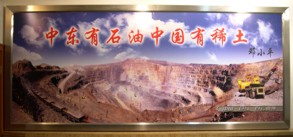 Photo
of the mine by the front desk of the hotel. I was surprised at
how small the pit was compared to some I've visited, especially
considering this is by far the biggest Rare Earth Element mine in the
world. It was my first REE mine, though, so I didn't know what to
expect. Studying the pit walls in the photo showed they'd
seriously steepend some of the high walls and it looks like they've had
a couple slope failures - I hope no one was hurt. I always get a
bad feeling when I see stuff like that.
Photo
of the mine by the front desk of the hotel. I was surprised at
how small the pit was compared to some I've visited, especially
considering this is by far the biggest Rare Earth Element mine in the
world. It was my first REE mine, though, so I didn't know what to
expect. Studying the pit walls in the photo showed they'd
seriously steepend some of the high walls and it looks like they've had
a couple slope failures - I hope no one was hurt. I always get a
bad feeling when I see stuff like that.
 Typical
Inner Mongolian grassland terrain near the mine. These are some
of the roads and exploration trenches dug by the mining company to
better characterize the geology in the area. These photos were
taken on the first day - before we were informed by the mining company
that we were forbidden from taking any photographs, video footage, rock
samples, or anything else except notes in our field notebooks.
I'd heard that REE companies are hyper-secretive (like diamond mines),
but we could have been much more productive scientifically without the
restrictions and constant security escort - and I think we could have
potentially helped the company, too! (I also felt bad for the
security escorts who had to follow us around in the field to make sure
we didn't break the rules - they were just guys doing their job.)
That said, I am very, very grateful for being granted the access we had
so I could see one of the world's greatest mineral deposits!
Typical
Inner Mongolian grassland terrain near the mine. These are some
of the roads and exploration trenches dug by the mining company to
better characterize the geology in the area. These photos were
taken on the first day - before we were informed by the mining company
that we were forbidden from taking any photographs, video footage, rock
samples, or anything else except notes in our field notebooks.
I'd heard that REE companies are hyper-secretive (like diamond mines),
but we could have been much more productive scientifically without the
restrictions and constant security escort - and I think we could have
potentially helped the company, too! (I also felt bad for the
security escorts who had to follow us around in the field to make sure
we didn't break the rules - they were just guys doing their job.)
That said, I am very, very grateful for being granted the access we had
so I could see one of the world's greatest mineral deposits! Lots of nice trenches!
Lots of nice trenches! Lisa
- she did a very good job and made some good mineral ID calls in the
field.
She was particularly enthusiastic the day we visited several so-called
carbonatite dikes (she likes igneous rocks and volcanoes). She
graduated and now has a great job as a geologist in the western
U.S. She's enjoying work, but I am hoping that she eventually goes to
graduate school after a few years of making big bucks because she
always did well on research projects with me (i.e., both this one and a
hydrogeology study the year before).
Lisa
- she did a very good job and made some good mineral ID calls in the
field.
She was particularly enthusiastic the day we visited several so-called
carbonatite dikes (she likes igneous rocks and volcanoes). She
graduated and now has a great job as a geologist in the western
U.S. She's enjoying work, but I am hoping that she eventually goes to
graduate school after a few years of making big bucks because she
always did well on research projects with me (i.e., both this one and a
hydrogeology study the year before). Kristen
graduated and is now studying hydrogeology at the University of West
Virginia. I think she's studying acid rock drainage, but I don't
really know since she doesn't write. I hope she's doing alright.
Kristen
graduated and is now studying hydrogeology at the University of West
Virginia. I think she's studying acid rock drainage, but I don't
really know since she doesn't write. I hope she's doing alright.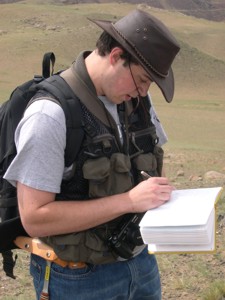 Zach
graduated and will study with Adam Simon at the University of Nevada
Las Vegas after working for a summer in industry. Zach
accompanied me to China again the following year (2005) to help teach
in
Beijing. He did a spectacular job both trips and I think he's one
of the most talented students I've met. He'll do good work with
Adam and I think UNLV is a great school.
Zach
graduated and will study with Adam Simon at the University of Nevada
Las Vegas after working for a summer in industry. Zach
accompanied me to China again the following year (2005) to help teach
in
Beijing. He did a spectacular job both trips and I think he's one
of the most talented students I've met. He'll do good work with
Adam and I think UNLV is a great school. 
 Outcrops
in the grasslands may not be bold, but geologic contacts can be fairly
easy to track. This narrow basalt dike can clearly be seen
tracking off into the distance. Finding places one can stick a
brunton compass on to get good orientation measurements isn't too bad,
either. I'd really like to see IR aerial photography of the place
in the spring because the vegetation really responded well to different
rock types and faults.
Outcrops
in the grasslands may not be bold, but geologic contacts can be fairly
easy to track. This narrow basalt dike can clearly be seen
tracking off into the distance. Finding places one can stick a
brunton compass on to get good orientation measurements isn't too bad,
either. I'd really like to see IR aerial photography of the place
in the spring because the vegetation really responded well to different
rock types and faults. 
 This
was a small gold mine at the north end of the district. The
miners had just gotten off work and were hanging around on one of the
dumps. They seemed like a friendly and curious group, but we were
trying to get some ground studied, so we didn't stop to talk.
This
was a small gold mine at the north end of the district. The
miners had just gotten off work and were hanging around on one of the
dumps. They seemed like a friendly and curious group, but we were
trying to get some ground studied, so we didn't stop to talk.
 Typical
quartz veins in gneiss at the gold mine. Pretty thin-looking
stuff, but low sulfide. I don't know what their grades or
recovery were.
Typical
quartz veins in gneiss at the gold mine. Pretty thin-looking
stuff, but low sulfide. I don't know what their grades or
recovery were. 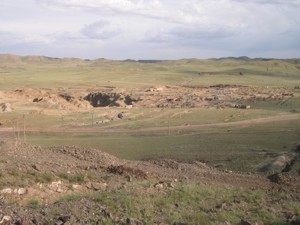
 This
is the region north of the REE mine where there are a couple smaller
gold mines and an old limonite mine. Xiao believes the limonite
mine was a hot spring. The Russian geologists who'd been here 30
years ago called it an iron cap (weathering deposit after
sulfides). The "town" in the background is where the exploration
staff were housed back when the company was first exploring the
district.
This
is the region north of the REE mine where there are a couple smaller
gold mines and an old limonite mine. Xiao believes the limonite
mine was a hot spring. The Russian geologists who'd been here 30
years ago called it an iron cap (weathering deposit after
sulfides). The "town" in the background is where the exploration
staff were housed back when the company was first exploring the
district.  The
group (sans me, of course - someone's got to take the
picture!)
The
group (sans me, of course - someone's got to take the
picture!)  Some
locals at the restaurant who were having a great time. I saw that
they were singing toasts and drinking baijiu (very strong,
colorless, distilled alcohol made from sorghum). I went over and
sang a few songs in toast with them and they were very welcoming.
People are great, aren't they?
Some
locals at the restaurant who were having a great time. I saw that
they were singing toasts and drinking baijiu (very strong,
colorless, distilled alcohol made from sorghum). I went over and
sang a few songs in toast with them and they were very welcoming.
People are great, aren't they?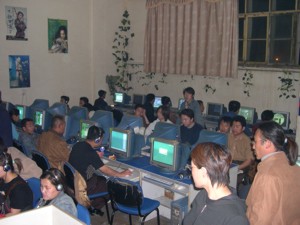 Even
in Inner Mongolia, one can connect to the internet. This is the
internet cafe in Baiyunebo. It's primarily a place where young
people go to play computer games, but it was nice for us to be able to
email home periodically and to look up the Mongolian alphabet so I
could try to read signs.
Even
in Inner Mongolia, one can connect to the internet. This is the
internet cafe in Baiyunebo. It's primarily a place where young
people go to play computer games, but it was nice for us to be able to
email home periodically and to look up the Mongolian alphabet so I
could try to read signs.
 Beautiful
views of the Inner Mongolian steppes. It was such a wonderful
place to be! Growing up in the west and now living in the eastern
U.S., I really miss the open spaces.
Beautiful
views of the Inner Mongolian steppes. It was such a wonderful
place to be! Growing up in the west and now living in the eastern
U.S., I really miss the open spaces.
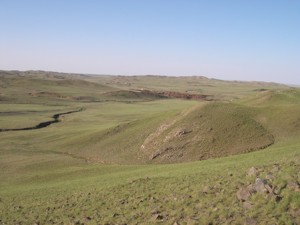 Again
we see evidence for a recent downcutting erosion.
Again
we see evidence for a recent downcutting erosion.  Zach
by a creek filled with cobbles of magnetite-bastnaesite "ore." A
nearby fellow spent his time collecting cobbles by hand and then
hauling them over the hill where he could sell them to a small mineral
processing mill. It's a tough life! Seeing so many cobbles
of ore in the stream really made me wonder how big this deposit was
before glaciation and several episodes of erosion.
Zach
by a creek filled with cobbles of magnetite-bastnaesite "ore." A
nearby fellow spent his time collecting cobbles by hand and then
hauling them over the hill where he could sell them to a small mineral
processing mill. It's a tough life! Seeing so many cobbles
of ore in the stream really made me wonder how big this deposit was
before glaciation and several episodes of erosion.  The waitresses at one of the local
restaurants. Several of the waitresses were fighting a cold and
so have reddening of their necks where they pinch the skin as a
remedy. It looked painful, but that's their way.
The waitresses at one of the local
restaurants. Several of the waitresses were fighting a cold and
so have reddening of their necks where they pinch the skin as a
remedy. It looked painful, but that's their way. The group with one of the
Baiyunebo mine administrators at Monkey Rock Temple - a local Buddhist
temple
set amongst interesting rock outcrops. We stopped here on our way
back to Hohhot.
The group with one of the
Baiyunebo mine administrators at Monkey Rock Temple - a local Buddhist
temple
set amongst interesting rock outcrops. We stopped here on our way
back to Hohhot.  Zach's photo of me stopping to
look and appreciate the outstanding scenery. Yeah, I know I
should have been working harder, but I loved being in such a beautiful place!!
Zach's photo of me stopping to
look and appreciate the outstanding scenery. Yeah, I know I
should have been working harder, but I loved being in such a beautiful place!!
